DWP CFO European Social Fund 2014 to 2020 statistics to May 2020
Published 26 August 2020
The latest release of these statistics can be found in the DWP CFO statistics collection.

This is the latest bi-annual release of experimental statistics on the Department for Work and Pensions (DWP) Co-Financing Organisation (CFO) European Social Fund 2014 to 2020 employment programme and includes data up to May 2020.
1. Introduction
The DWP CFO employment programme for the European Social Fund (ESF) 2014 to 2020 is an EU funded programme across England aimed at unemployed or inactive individuals. Participants will either be long term unemployed or inactive (26 weeks or longer), or have a barrier to work, such as a basic skills need, a health condition, or caring responsibilities.
Since September 2016, the provision spread across 25 of the 38 Local Enterprise Partnerships (LEPs) across England, with up to 33 contracts delivering the provision. There are currently 17 contracts taking referrals, 6 of which are in London.
This statistical publication refers only to the element of ESF 2014 to 2020 operated by DWP as a CFO.
Coronavirus (COVID-19)
Government measures taken during the coronavirus (COVID-19) pandemic have had an impact on the delivery of the programme and on its performance in the most recent months reported in this release.
DWP has taken interim arrangements to allow the delivery of the DWP CFO ESF 2014 to 2020 provision in line with the government measures, details can be found in the provider guidance.
2. Main Stories
Since the DWP CFO ESF 2014 to 2020 began:
- 67,230 participants have started the employment programme up to May 2020
- 16,280 (29%) of starts up to May 2019 have achieved a Short Job Outcome
- 13,550 (24%) of starts up to May 2019 have achieved a Sustained Job Outcome
Figure 1: Monthly number of starts and job outcomes, September 2016 to May 2020
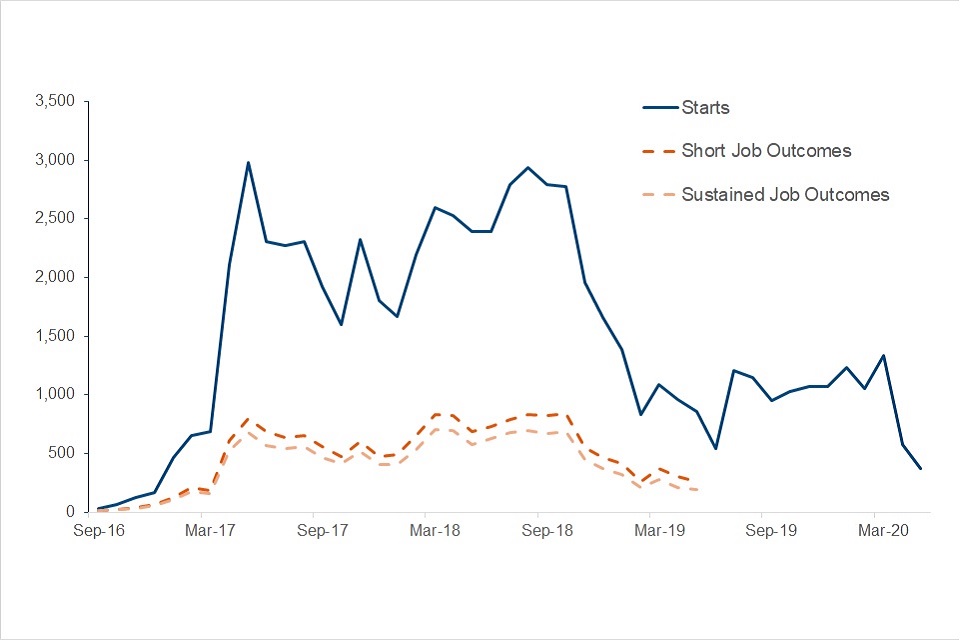
Source: DWP CFO ESF 2014 to 2020 data tables.
3. What you need to know
What is DWP CFO ESF 2014 to 2020
The ESF programme from 2014 to 2020 is a 7-year round of funding from the EU as part of the European Structural and Investment Funds Growth Programme (ESIF). The ESIF is predominantly made up of the following three arms:
- European Regional Development Fund (ERDF)
- European Social Fund (ESF)
- European Agricultural Fund for Rural Development (EAFRD)
DWP CFO ESF 2014 to 2020 aims to improve employment opportunities, promote social inclusion and invest in skills by providing the help people need to meet their potential.
The programme is split geographically by Category of Region:
- More Developed (Gross Domestic Product (GDP) per capita above 90% of EU average) – this covers most of England
- Transitional (GDP per capita 75% to 90% of EU average) – there are 9 transitional areas in England
- Less Developed (GDP per capita below 75% of EU average) – Cornwall and the Isles of Scilly is the only region in England in this category
For the period covered by this publication, the providers delivering DWP CFO ESF 2014 to 2020 receive:
- a fixed monthly delivery fee
- payments for Short Job Outcomes, where an individual has 13 cumulative weeks in employment over a period of 26 weeks
- payments for Sustained Job Outcomes, where an individual has 26 cumulative weeks in employment over 52 weeks
DWP CFO ESF 2014 to 2020 provision was developed in consultation with LEPs to allow the provision to meet local needs. Depending on local circumstances and priorities, most LEPs identified particular categories of eligible participants on which it wanted its provision to focus (see DWP CFO ESF 2014 to 2020 provider guidance for more details).
Some LEPs also asked for particular activities to be included within the provision. At the start of the programme, some contracts had stricter eligibility criteria than the rest, however this resulted in a low level of referrals and eligibility has now been widened to increase participant volumes. The London contracts have their own unique eligibility requirements, for example a focus on people aged 50 years and above.
What do these statistics show?
This publication includes figures on starts and job outcomes for the DWP CFO ESF 2014 to 2020 from September 2016. The data has been taken from the DWP Provider Referrals and Payments (PRaP) dataset. The June 2020 PRaP dataset has been used to report data on starts taken up to the end of May 2020 and on job outcomes for starts up to the end of May 2019, to allow participants time to achieve the outcomes.
4. Starts to DWP CFO ESF 2014 to 2020
Over 67,230 starts to the DWP CFO ESF 2014 to 2020 provision up to May 2020.
Figure 2: Monthly number of starts by Category of Region, September 2016 to May 2020
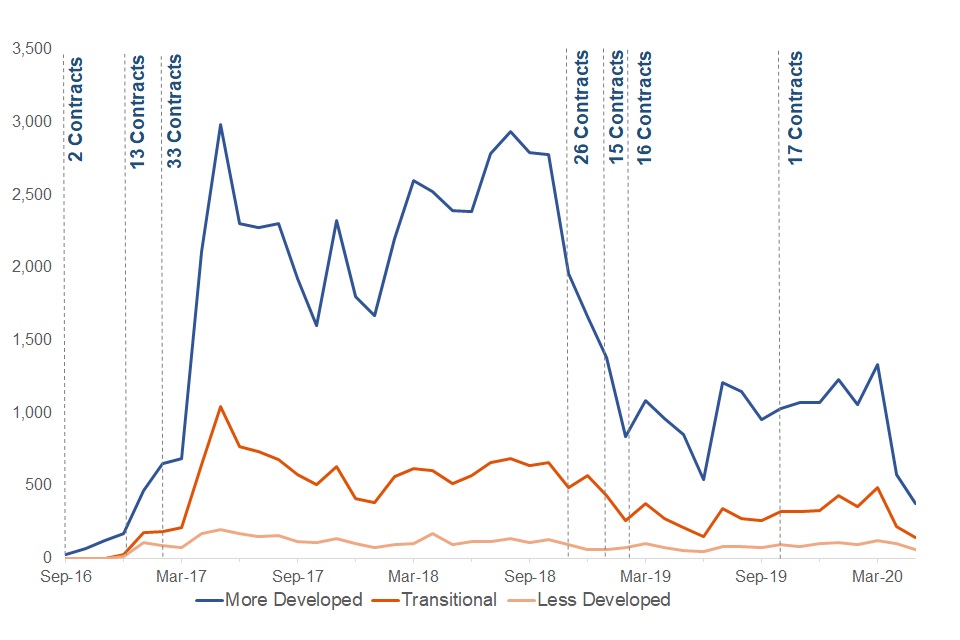
Source: DWP CFO ESF 2014 to 2020 data tables.
Thirty-one contracts started taking referrals in 3 phases between September 2016 and February 2017. By February 2019, 15 of the original contracts were extended and continued taking referrals. In October 2019, 2 contracts were launched in 2 LEPs previously not part of DWP CFO ESF 2014 to 2020.
All of the contracts which were not extended stopped taking new referrals, however they were contractually required to provide support to existing participants for the time they were on the programme.
Figure 2 shows the time line of these changes, reporting the number of contracts taking referrals when those changes took place.
These changes are clearly reflected in the number of starts per month, which rose significantly between September 2016 and March 2017 (31 contracts live) and decreased from November 2018.
See Table 1 of the data tables accompanying this release for full data.
5. Job Outcomes for DWP CFO ESF 2014 to 2020
29% of starts achieved a Short Job Outcome.
Figure 3: Percentage of starts achieving a Short Job Outcome by month of start, September 2016 to May 2019
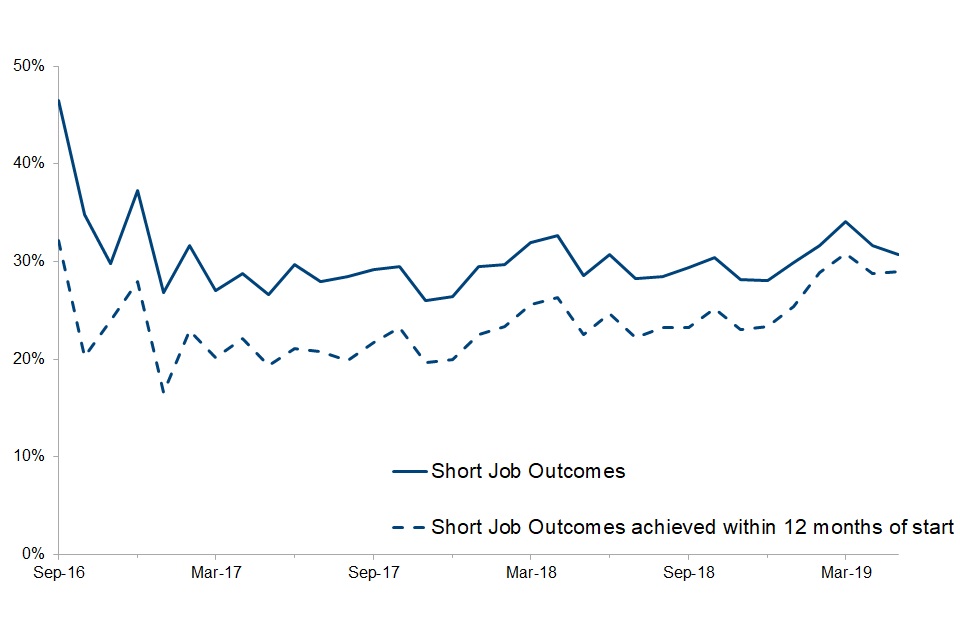
Source: DWP CFO ESF 2014 to 2020 data tables.
For starts up to May 2019, 29% achieved a Short Job Outcome, spending at least 13 weeks in employment during a 26-week consecutive period.
Participants achieving a Short Job Outcome within 12 months of their start date represent 23% of starts up to May 2019; 79% of all the Short Job Outcomes achieved by the programme up to this point.
See Table 2 of the data tables accompanying this release for full data.
24% of starts achieved a Sustained Job Outcome.
Figure 4: Percentage of starts achieving a Sustained Job Outcome by month of start, September 2016 to May 2019
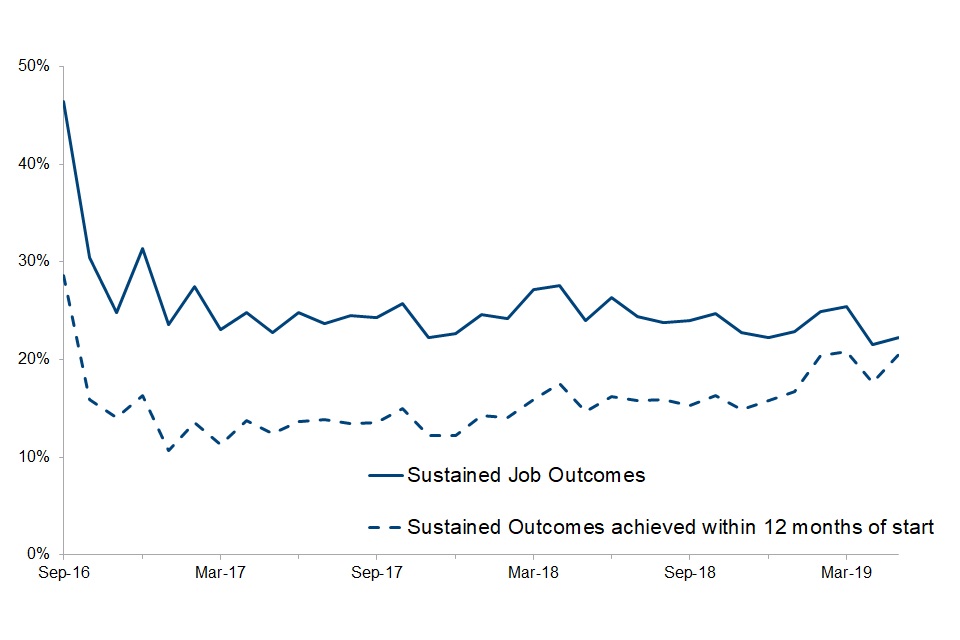
Source: DWP CFO ESF 2014 to 2020 data tables.
For starts up to May 2019, 24% achieved a Sustained Job Outcome. This means they were in employment for 26 weeks in a 52-week consecutive period.
Participants achieving a Sustained Job Outcome within 12 months of their start date represent 15% of starts up to May 2019; 62% of all the Sustained Job Outcomes achieved by the programme up to this point.
See Table 3 of the data tables accompanying this release for full data.
In both charts, the number of starts in September 2016 was substantially lower than the following months, resulting in a larger proportion of starts achieving a job outcome.
6. Characteristics of people who started DWP CFO ESF 2014 to 2020
People starting DWP CFO ESF 14-20 are more likely to be male (56%) than female.
Figure 5: Percentage of starts by Gender, September 2016 to May 2020
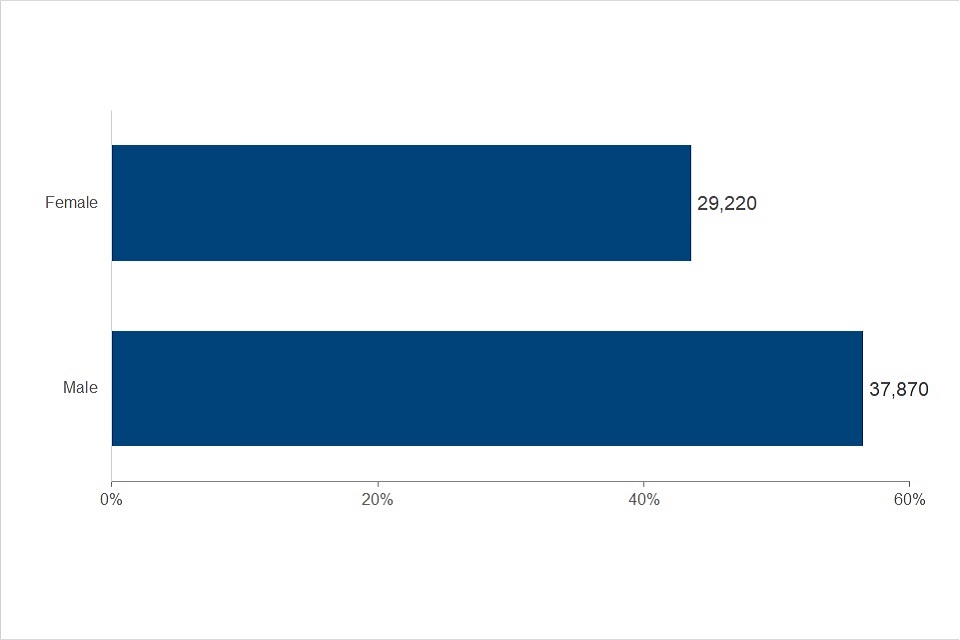
Source: DWP CFO ESF 14-20 data tables.
See Table 4.1 of the data tables accompanying this release for full data.
Around half of participants are aged between 25 and 49 years.
Figure 6: Percentage of age groups by LEPs, September 2016 to May 2020
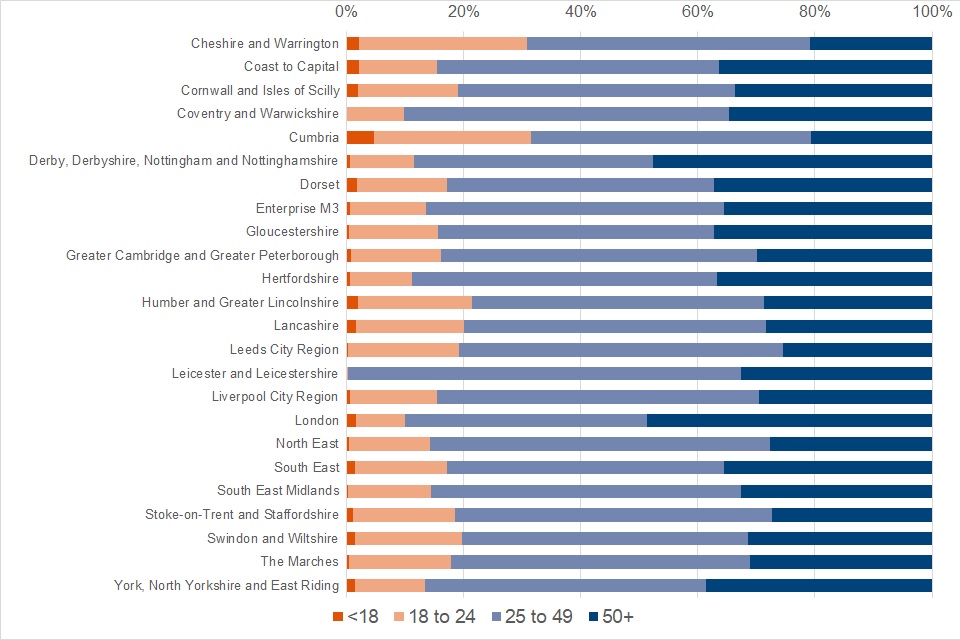
Source: DWP CFO ESF 2014 to 2020 data tables.
Almost half (49%) of all people starting the programme come from the 25 to 49 age group, whereas 36% are over 50 years old.
The distribution of age varies by LEPs, as different LEPs have chosen to focus on different output indicators within the programme. For example, Cheshire and Warrington has the highest proportion of 18 to 24 year olds starting the programme (29%) as they will have chosen to focus specifically on that age group,
Leicester and Leicestershire has the highest proportion of 25 to 49 year olds starting the programme (67%) and London has the highest proportion of those 50 years and above starting the programme (49%). Four of the eight contracts delivered in London are aimed at older workers, this explains the higher proportion of over 50 year olds recorded in this LEP.
See Table 4.1 and Table 4.2 of the data tables accompanying this release for full data.
More than one in four of those starting DWP CFO ESF 2014 to 2020 come from Black, Asian and Minority Ethnic groups.
Figure 7: Percentage of starts by those from Black, Asian and Minority Ethnic groups, September 2016 to May 2020
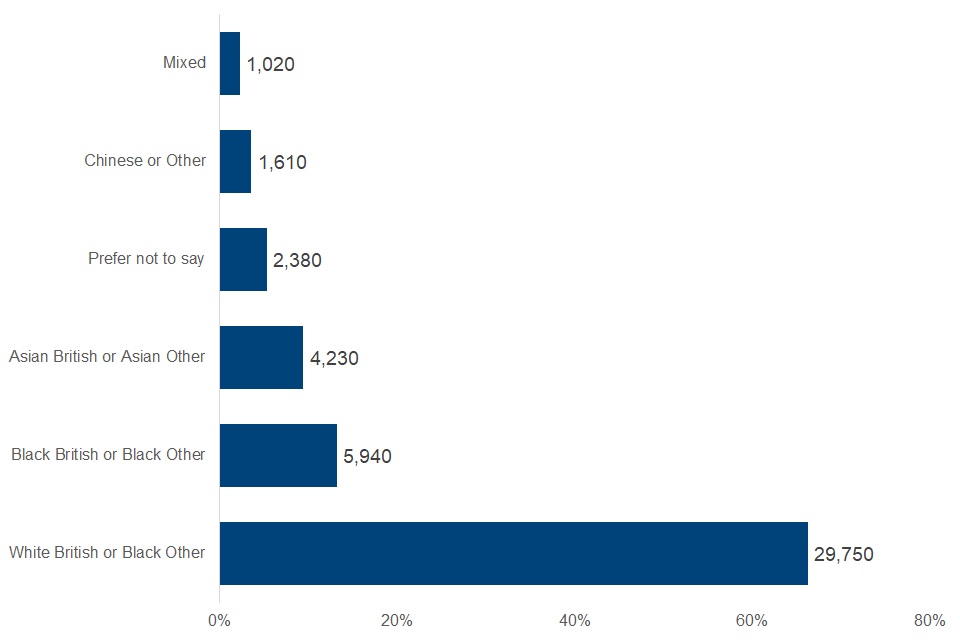
Source: DWP CFO ESF 2014 to 2020 data tables.
The majority of people on DWP CFO ESF 2014 to 2020 (66%) identified themselves as white. A further 28% identified themselves as belonging to a Black, Asian and Ethnic Minority community; whereas 5% preferred not to specify their ethnicity.
See Table 4.1 of the data tables accompanying this release for full data.
Less than half (43%) of participants reports a self-declared disability.
Figure 8: Percentage of starts by Self-declared Disability, September 2016 to May 2020
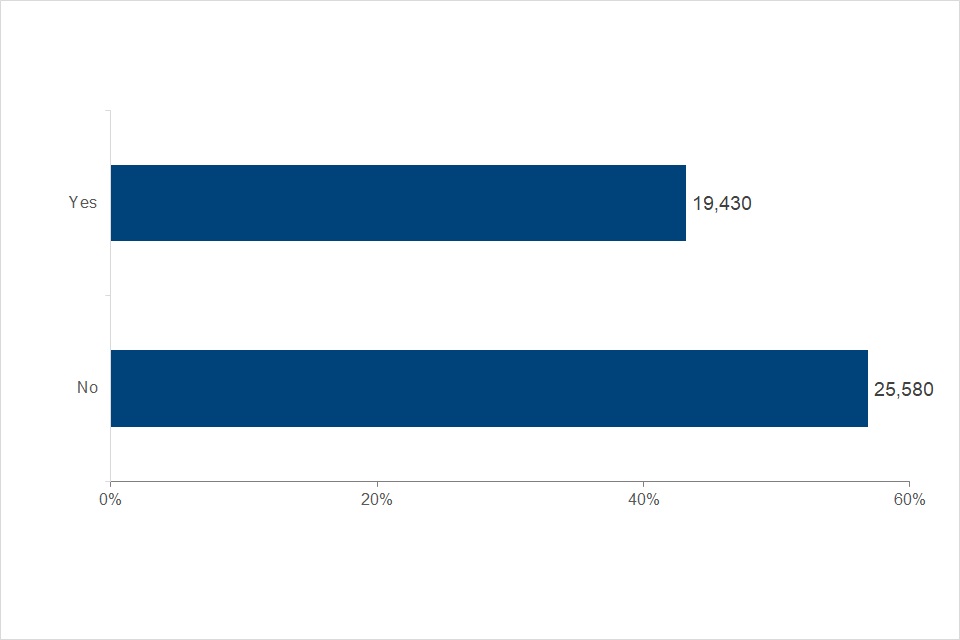
Source: DWP CFO ESF 2014 to 2020 data tables.
See Table 4.1 of the data tables accompanying this release for full data.
Note: The ethnicity and disability status of 22,090 people (33% of all starts) who were claiming Universal Credit when they joined provision is unknown, as this data is not available for this customer group. Percentages reported in all figures are computed on all starts except records for which the information is unknown. In figure 7 and 8 the unknown category includes participants claiming Universal Credit.
7. Main benefit of DWP CFO ESF 2014 to 2020 participants
Almost half (49%) of people starting DWP CFO ESF 2014 to 2020 are claiming Jobseeker’s Allowance (JSA), Employment and Support Allowance (ESA) or Income Support (IS).
Figure 9: Percentage of starts by Benefit Type, September 2016 to May 2020

Source: DWP CFO ESF 2014 to 2020 data tables.
As the roll-out of Universal Credit (UC) has progressed across England, the number of participants claiming UC when they joined the programme increased.
Also the proportion of starts not claiming any of the out of work benefits reported in the graph when they joined the programme has gradually increased over the last two years.
See Table 5 of the data tables accompanying this release for full data.
8. Contractual Performance
The providers delivering DWP CFO ESF 2014 to 2020 have a performance level for the amount of Short and Sustained Job Outcomes they are expected to achieve each month.
Actual performance is measured against this expected performance level. The performance shown here is actual performance as a percentage of expected performance over a 12-month period.
Between June 2019 to May 2020, 10 out of 22 LEPs and 14 out of 31 contracts met or exceeded their expected number of Short Job Outcomes, getting people in work for at least 13 out of 26 weeks
Figure 10: Short Job Outcomes as a percentage of expected performance (June 2019 to May 2020) by LEP
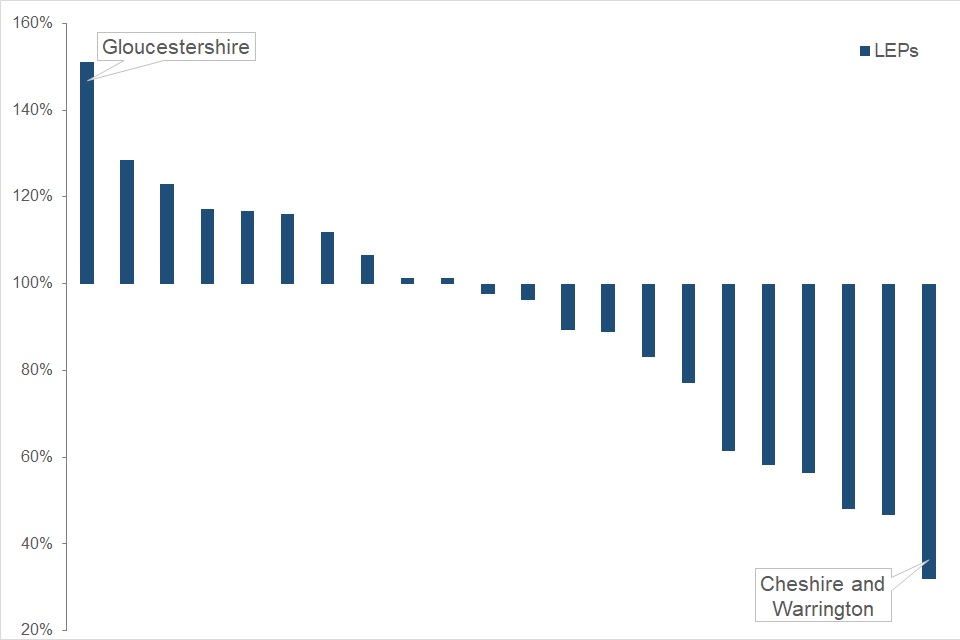
Source: DWP CFO ESF 2014 to 2020 data tables.
Between June 2019 to May 2020, 8 of the 22 LEPs and 13 of the 31 contracts met or exceeded their expected number of Sustained Job Outcomes, getting people in work for at least 26 out of 52 weeks
Figure 11: Sustained Job Outcomes as a percentage of expected performance (June 2019 to May 2020) by LEP
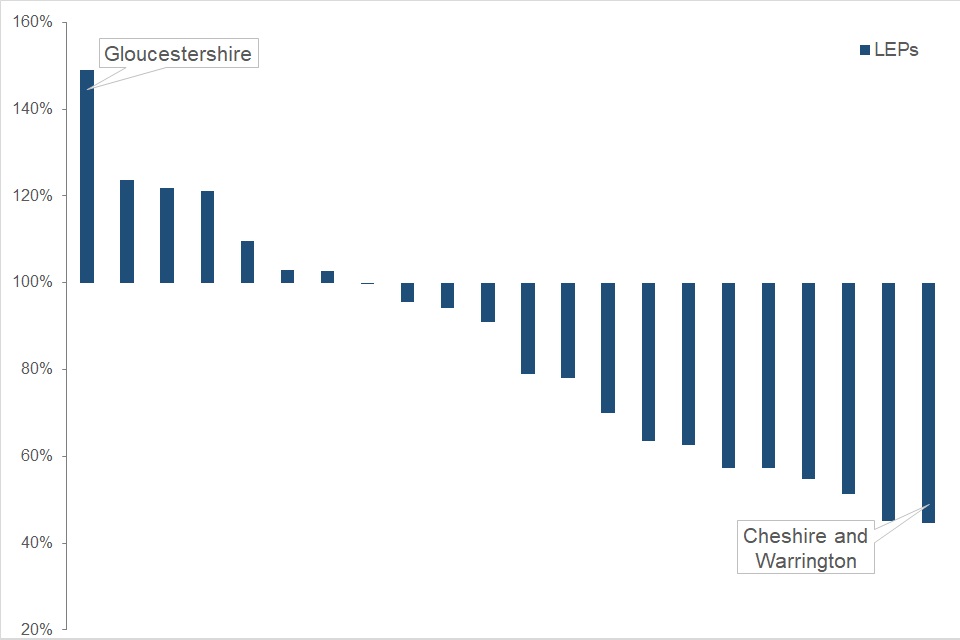
Source: DWP CFO ESF 2014 to 2020 data tables.
See Table 6 for full data on performance information for each contract and background information for more details about contractual information.
9. About these statistics
This statistical summary gives an overview of the DWP Co-Financing Organisation (CFO) employment programme for the European Social Fund 2014 to 2020. Key points and trends are presented using charts and commentary. The information underlying the charts is available in the data tables.
Data for these statistics is derived from the:
- DWP Provider Referrals and Payments System (PRaP)
- Labour Market Systems Opportunities Dataset
- National Benefit Database
- Universal Credit Official Statistics Dataset
- Client Extract Data
Some data within this publication may be subject to revisions. For more information on the revisions policy see the DWP CFO European Social Fund 2014 to 2020 experimental statistics: background information.
Experimental Statistics
Experimental statistics are Official Statistics which are published in order to involve users and stakeholders in their development and as a mean to build in quality at an early stage. All Official Statistics should comply with the UK Statistics Authority’s Code of Practice for Statistics which promotes the production and dissemination of Official Statistics that inform decision making.
Where to find out more
The background information and the DWP CFO ESF 2014 to 2020 provider guidance provide further information on DWP CFO European Social Fund 2014 to 2020 employment programme and statistics.
Read information about how DWP operates as one of the co-financing organisations for the DWP CFO ESF 2014 to 2020 programme.
DWP publishes statistics for a wide range of employment support schemes, including:
- Access to Work
- New Enterprise Allowance
- Specialist Employability Support
- Work Choice
- Work Programme
- Work and Health Programme
View the full collection of DWP statistical releases.
Contact information and feedback
For more information on DWP CFO European Social Fund 2014 to 2020 statistics, please contact giovanna.mollo@dwp.gov.uk.
DWP would like to hear your views on our statistical publications. If you use any of our statistics publications, we would be interested in hearing what you use them for and how well they meet your requirements. Please contact stats-consultation@dwp.gov.uk.
